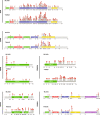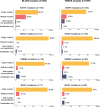Targeted exome sequencing identifies mutational landscape in a cohort of 1500 Chinese patients with non-small cell lung carcinoma (NSCLC)
- PMID: 33845897
- PMCID: PMC8042687
- DOI: 10.1186/s40246-021-00320-9
Targeted exome sequencing identifies mutational landscape in a cohort of 1500 Chinese patients with non-small cell lung carcinoma (NSCLC)
Abstract
Background: Non-small cell lung carcinoma (NSCLC) is one of the most common human cancers, comprising approximately 80-85% of all lung carcinomas. An estimated incidence of NSCLC is approximately 2 million new cases per year worldwide.
Results: In recent decade, the treatment of NSCLC has made breakthrough progress owing to a large number of targeted therapies which were approved for clinical use. Epidemiology, genetic susceptibility, and molecular profiles in patients are likely to play an important factor in response rates and survival benefits to these targeted treatments and thus warrant further investigation on ethnic differences in NSCLC. In this study, a total number of 1500 Chinese patient samples,1000 formalin fixed paraffin-embedded (FFPE) and 500 blood samples, from patients with NSCLC were analyzed by targeted sequencing to explore mutational landscape in ethnic groups associated with China.
Conclusions: Overall, the data presented here provide a comprehensive analysis of NSCLC mutational landscape in Chinese patients and findings are discussed in the context of similar studies on different ethnic groups.
Keywords: Cancer; Chinese patients; Disease; Non-small cell lung carcinoma; Targeted exome sequencing.
Conflict of interest statement
The authors declare that they have no competing interests.
Figures





Similar articles
-
Genomic Signature of Driver Genes Identified by Target Next-Generation Sequencing in Chinese Non-Small Cell Lung Cancer.Oncologist. 2019 Nov;24(11):e1070-e1081. doi: 10.1634/theoncologist.2018-0572. Epub 2019 Mar 22. Oncologist. 2019. PMID: 30902917 Free PMC article.
-
Targeted next-generation sequencing for cancer-associated gene mutation and copy number detection in 206 patients with non-small-cell lung cancer.Bioengineered. 2021 Dec;12(1):791-802. doi: 10.1080/21655979.2021.1890382. Bioengineered. 2021. PMID: 33629637 Free PMC article.
-
Expression Profiling of Driver Genes in Female Never-smokers With Non-adenocarcinoma Non-small-cell Lung Cancer in China.Clin Lung Cancer. 2020 Sep;21(5):e355-e362. doi: 10.1016/j.cllc.2020.02.005. Epub 2020 Feb 10. Clin Lung Cancer. 2020. PMID: 32139332
-
Measurement of tumor mutational burden (TMB) in routine molecular diagnostics: in silico and real-life analysis of three larger gene panels.Int J Cancer. 2019 May 1;144(9):2303-2312. doi: 10.1002/ijc.32002. Epub 2019 Feb 4. Int J Cancer. 2019. PMID: 30446996
-
Optimizing the sequencing of tyrosine kinase inhibitors (TKIs) in epidermal growth factor receptor (EGFR) mutation-positive non-small cell lung cancer (NSCLC).Lung Cancer. 2019 Nov;137:113-122. doi: 10.1016/j.lungcan.2019.09.017. Epub 2019 Sep 23. Lung Cancer. 2019. PMID: 31568888 Free PMC article. Review.
Cited by
-
Stem cell-derived organoid models for SARS-CoV-2 and its molecular interaction with host cells.Mol Biol Rep. 2023 Dec;50(12):10627-10635. doi: 10.1007/s11033-023-08785-8. Epub 2023 Sep 23. Mol Biol Rep. 2023. PMID: 37740859 Review.
-
A novel SLC8A1-ALK fusion in lung adenocarcinoma confers sensitivity to alectinib: A case report.Open Life Sci. 2022 Aug 11;17(1):846-850. doi: 10.1515/biol-2022-0090. eCollection 2022. Open Life Sci. 2022. PMID: 36045716 Free PMC article.
-
Genomic Alteration Spectrum of Non-Small Cell Lung Cancer Patients in East-China Characterized by Tumor Tissue DNA and Cell-Free DNA.Onco Targets Ther. 2022 May 19;15:571-584. doi: 10.2147/OTT.S351085. eCollection 2022. Onco Targets Ther. 2022. PMID: 35615557 Free PMC article.
-
Transcriptomic and immunologic implications of the epithelial-mesenchymal transition model reveal a novel role of SFTA2 in prognosis of non-small-cell lung carcinoma.Front Genet. 2022 Aug 26;13:911801. doi: 10.3389/fgene.2022.911801. eCollection 2022. Front Genet. 2022. PMID: 36092941 Free PMC article.
-
Mutational differences between primary cancer tissue and circulating tumor cells in early-stage non-small cell lung cancer.Transl Lung Cancer Res. 2024 Nov 30;13(11):3026-3038. doi: 10.21037/tlcr-24-709. Epub 2024 Nov 12. Transl Lung Cancer Res. 2024. PMID: 39669998 Free PMC article.
References
-
- Suster DI, Mino-Kenudson M. Molecular pathology of primary non-small cell lung cancer. Arch Med Res. 2020. - PubMed
-
- Shi Y, Au JS, Thongprasert S, Srinivasan S, Tsai CM, Khoa MT, et al. A prospective, molecular epidemiology study of EGFR mutations in Asian patients with advanced non-small-cell lung cancer of adenocarcinoma histology (PIONEER) J Thorac Oncol. 2014;9(2):154–162. doi: 10.1097/JTO.0000000000000033. - DOI - PMC - PubMed
-
- Mosele F, Remon J, Mateo J, Westphalen CB, Barlesi F, Lolkema MP, Normanno N, Scarpa A, Robson M, Meric-Bernstam F, Wagle N, Stenzinger A, Bonastre J, Bayle A, Michiels S, Bièche I, Rouleau E, Jezdic S, Douillard JY, Reis-Filho JS, Dienstmann R, André F. Recommendations for the use of next-generation sequencing (NGS) for patients with metastatic cancers: a report from the ESMO Precision Medicine Working Group. Ann Oncol. 2020;31(11):1491–1505. doi: 10.1016/j.annonc.2020.07.014. - DOI - PubMed
Publication types
MeSH terms
LinkOut - more resources
Full Text Sources
Other Literature Sources

